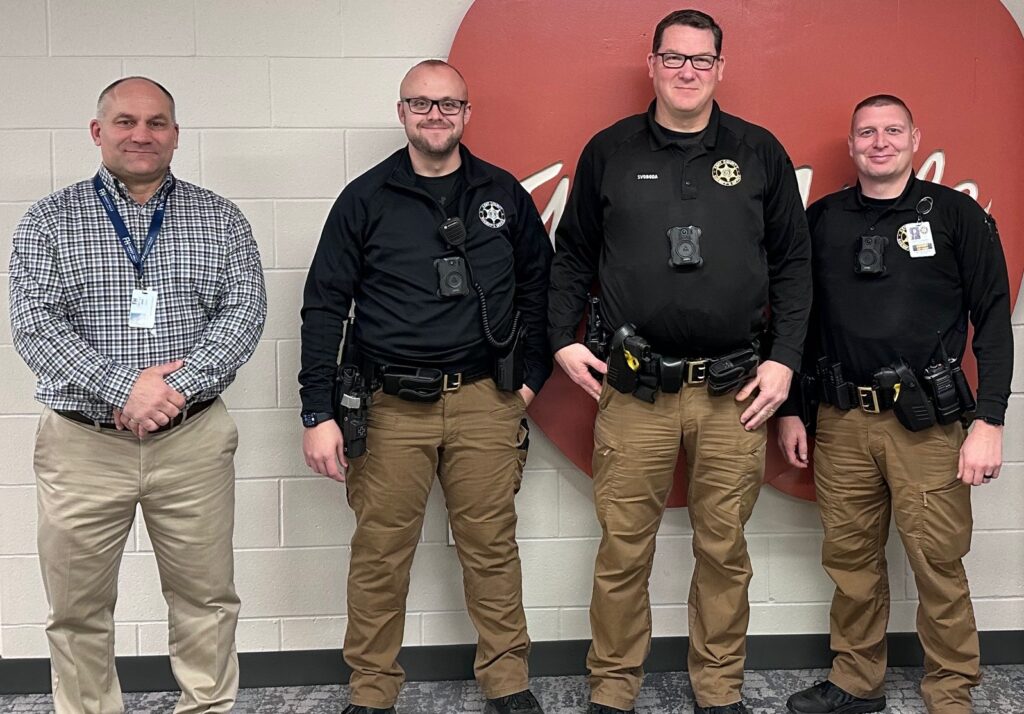
The safety and security of our students, staff, and visitors is our number one priority and is the shared responsibility of every administrator, staff member, student, and visitor in the district.
School Safety, Security Director and District Resource Officers
The district has a director of school safety and security, Ryan Kimball, along with three School Resource Officers (SROs). The SROs are through the Kent County Sheriff’s Department. These individuals routinely visit our schools, interact with staff, students, and families, and help maintain a culture of open communication and safety while building positive relationships with students. Deputy Ben Dunneback services the Northern side of the district, Deputy Cory Czaika services the Eastern side of the district, and Deputy Jim Svoboda services the Central side of the district.

From left: Ryan Kimball, Deputy Czaika, Deputy Svoboda, Deputy Dunneback.
Recent Presentations and Forums
The school district holds informational community presentations and forums at various times throughout the year.
The most recent Safety and Security forum from September of 2022 can be found as a video recording on Vimeo.
Emergency Plans
While everyone hopes that an emergency event will never occur, Forest Hills Public Schools has developed emergency preparation and response plans that can be applied consistently across the district. Our emergency plans have been developed with the assistance of administrators, building staff members, the Kent County Sheriff’s Department (KCSD), school resource officers, KCSD’s emergency management coordinator, local fire chiefs, and the Michigan State Police bomb squad.
Our emergency plans consist of the following documents.
Emergency Operations Plans (EOP)
EOPs provide detailed response actions that will be employed to address the broad range of situations that may arise. These confidential documents are used as reference and training tools throughout the district. Responsibilities of administrators, building staff, students, first responders, and parents are outlined along with any preparation and follow-up actions.
Classroom EMERGENCY Quick Reference Guides
These binders are provided in classrooms throughout the district. They are consistent in their content and contain a tailored egress/shelter map so that all staff members or substitutes who serve in our buildings are able to address hazards that arise and respond accordingly.
They provide abbreviated instructions that address the following:
- Responses:
- Lockdown
- Lockout
- Evacuation
- Shelter-in-Place
- Hazards:
- Active Violence
- Intruder/Trespassing
- Medical Emergency
- Cardiac Emergency
- Severe Weather
- Fire/Explosion
Office EMERGENCY Quick Reference Guides
The Office EMERGENCY Quick Reference Guides contain all of the responses and hazards that are contained in the Classroom EMERGENCY Quick Reference Guides. Additionally, they address the following:
- Responses:
- Relocation
- Reunification
- Hazards:
- Verbal/Written Threat
- Bomb Threat
- Flooding
- Utility Failure
- Chemical, Biological, and Radiological/Nuclear Incidents
Corridor Maps
Corridor maps are effective for way-finding in our buildings, but they also include the following important safety information in non-classroom or high-occupancy spaces such as offices, cafeterias, and gymnasiums:
- Emergency egress routes and tornado shelter locations
- Fire alarm pull stations and fire extinguishers
- Emergency automated external defibrillator locations
Safety Drills
All Michigan public schools are required by law to perform fire, tornado, and lockdown drills at prescribed times throughout the year. Records of the drills are also required to be posted for a minimum period of three years. Links to these records can be found below.
FAQs
Safety and security are often the result of doing the same thing, all the time, in a predictable manner. Below are some guidelines that have been provided to every employee in the district:
- All staff members are required to wear identification and visitors are required to sign in and obtain temporary identification at the front office during normal business hours.
- Exterior doors are to be locked throughout the day during non-arrival and dismissal times.
- Classroom locks are to be left in a locked state so that doors lock on closure.
- Be observant of your surroundings and the people in our buildings and identify any issues that don’t appear to be “normal.”
Active violence situations are highly unlikely but cause the most concern. Below are actions that would be employed:
- Buildings will initiate a LOCKDOWN and notify occupants of the threat.
- ACTIVE VIOLENCE INCIDENT instructions are to be followed.
- During an incident, staff, students, and visitors should employ RUN/HIDE/FIGHT tactics endorsed by the Department of Homeland Security based on the circumstances they are experiencing.
- Grade-level videos that explain and provide instruction about RUN/HIDE/FIGHT have been viewed by FHPS employees. These videos have been reviewed and approved for use in training by FHPS, our security consultant, and local fire and law enforcement agencies, and are available upon request.
- During an incident, staff, students, and visitors should employ RUN/HIDE/FIGHT tactics endorsed by the Department of Homeland Security based on the circumstances they are experiencing.
- RUN/HIDE/FIGHT are used as short, memorable words that describe the responses available during an active violence situation.
- Any of the three can be used non-sequentially to promote the safety of an individual or group of people.
- These terms are often used in Homeland Security training for offices and public places.
- During an active violence situation, RUN and HIDE are the preferred defense strategies to protect occupants. FIGHT is only to be used “to neutralize the threat if lives are in imminent danger. Active resistance may increase the chance of survival, but this is strictly a personal decision.” (FHPS Office and Classroom EMERGENCY Quick Reference Guides – Active Violence Incident)
- RUN is a tactic used to put distance between an attacker and potential victims.
- RUN may lead potential victims to a more secure HIDE location or to the exterior of the building.
- EVACUATION is a more controlled response that is used during a fire, gas leak, etc. “when conditions are safer outside than inside a building. It requires all staff/students to leave the building immediately.” FHPS EOP pp.2-1
- HIDE is a component of the LOCKDOWN response. It is the act of seeking cover that will stop a bullet or weapon and/or concealment in a location that will not stop a bullet or weapon and barricading in a safer location.
- Both LOCKDOWN and LOCKOUT responses provide consistent methods for hardening the exterior and interior of the building from a potential or active attacker by employing locked interior and exterior doors and windows and reduced passage/visibility of individuals. It is simply the act of preparing the building and occupants for subsequent action.
- LOCKDOWNS and LOCKOUTS are primarily thought of as responses to active violence incidents, but can also be used for intruder/trespassing, verbal/written threat, or bomb threat.
- LOCKDOWN is employed “when a person or situation presents an immediate threat to students/staff in or near the building. All exterior doors and classroom doors are locked and students/staff stay in their offices, work areas, and classrooms.” (FHPS EOP pp.2-1)
- LOCKOUT prepares the building occupants for an escalation to a LOCKDOWN and is employed “when there is an incident outside the building that could jeopardize the safety of students/staff. All outdoor activities are canceled and staff and classes are immediately moved to indoor areas. Occupants move about within the building but with minimized/eliminated corridor activity and a heightened awareness of where students are at all times.” (FHPS EOP pp.2-1)
- SHELTER-IN-PLACE “is employed when conditions are safer inside the building than outside.”
- For severe weather sheltering, students/staff are held in building-safe areas, such as interior rooms or a basement, away from windows.
- For hazardous material release outdoors with toxic vapors, students/staff are to remain in their classrooms, with windows and doors sealed and all ventilation systems shut off. “Limited movement may be allowed. Taking shelter inside a sealed building is highly effective in keeping students/staff safe.” (FHPS EOP pp.2-1)
- A REVERSE EVACUATION is simply the process of moving outside staff and classes to indoor areas when an outside threat is identified.
- Door Latching: “While the concept has merit from a security standpoint, placing magnets or other devices that circumvent the positive latching of the corridor doors is a violation of the New and Existing School, College, and University Fire Safety Administrative Rules (School Fire Safety Rules), which adopt NFPA 101 1997 Edition with amendments promulgated under Public Act 207 of 1941.”
- Barricade Devices: “Barricade situations are not addressed in the Life Safety Code. However, a lockdown device that is acceptable to be used as a barricade for a classroom door may not be installed on the door or door frame.”








